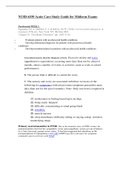Summary
Summary NURS 6550 Acute Care Midterm Exam Study Guide
- Course
- Institution
NURS 6550 Acute Care Study Guide for Midterm Exams Psychosocial WEEK 2 Papadakis, M. A., McPhee, S. J., & Rabow, M. W. (2018). Current medical diagnosis & treatment (57th ed.). New York, NY: McGraw Hill. Chapter 25, “Psychiatric Disorders” (pp. ) • Evaluate patients with psychosocial heal...
[Show more]



